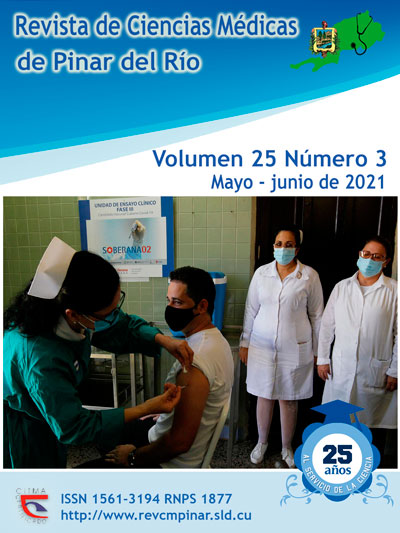Behavior of non-traumatic lower limb amputations during 2019-2020
Keywords:
AMPUTATION, DIABETES MELLITUS, PERIPHERAL ARTERIAL DISEASE, ATHEROSCLEROSIS.Abstract
Introduction: amputation may be the oldest surgical procedures.
Objective: to assess the behavior of non-traumatic lower limb amputations in Pinar del Rio province during the years 2019-2020.
Methods: a descriptive, longitudinal and cross-sectional study of non-traumatic lower limb amputations was conducted at Abel Santamaria Cuadrado General Teaching Hospital during the years 2019-2020. The target group comprised 488 patients, all of them were studied. Descriptive statistics was applied by means of absolute and relative percentages.
Results: amputations increased discreetly in 2020 (5 %) due to peripheral vascular disease, along with diabetes mellitus being the first cause (60 %), followed by obliterating atherosclerosis with major amputations as the most frequent (82 %), and of them supracondylar amputations (69 %).
Conclusions: peripheral vascular disease constitutes a high risk of lower limb amputations in patients without possibilities of revascularization in correspondence with the major supracondylar ones, and diabetes mellitus as the first cause for non-traumatic amputations.
Downloads
References
1. Vázquez Vela Sánchez E. Los amputados y su rehabilitación un reto para el estado. Academia Nacional de Medicina de México [Internet]. 2016 [citado7/12/2020]: 1-162. Disponible en: https://www.anmm.org.mx/publicaciones/ultimas_publicaciones/Rehabilitacion.pdf
2. Martínez Díaz Y, Fernández Quintana LC, Cabrera Zamora JL, Almeida Hernández L. Calidad de vida en pacientes con enfermedad arterial periférica de miembros inferiores en estadios iniciales. Rev Cubana de Angiol [Internet] 2018 [citado 7/12/2020]; 19(1):17-27: Disponible en: http://scielo.sld.cu/scielo.php?script=sci_arttext&pid=S1682-00372018000100003
3. Aguilera Lagos R, Díaz López EJ, Colman Juárez BL, Carranza Pagoada RE, Padilla Meza JC, Cáceres Munguía GI. Enfermedad arterial periférica y diabetes mellitus de tipo 2 en atención primaria. Rev Cubana Angiol Cir Vasc. [Internet]. 2020 [citado7/12/2020]; 21 (2): Disponible en: http://scielo.sld.cu/scielo.php?script=sci_arttext&pid=S1682-00372020000200003
4. Li Y, Burrows NR, Gregg EW, Albright A, Geiss LS. Declining rates of hospitalization for nontraumatic lower-extremity amputation in the diabetic population aged 40 years or older: U.S., 2008–2018. Diabetes Care [Internet]. 2018 Feb [citado7/12/2020]; 35(2): 273–7. Disponible en: https://care.diabetesjournals.org/content/35/2/273.short
5. Shugulí Curillo AE. Prevalencia de enfermedad arterial periférica según el índice tobillo-brazo en los pacientes con Diabetes Mellitus tipo 2 que acuden al centro de salud Centro Histórico, durante el período junio-julio 2016. Quito, Ecuador: Universidad Central del Ecuador [Internet]. 2017 [citado 31/01/2020]. Disponible en: http://www.dspace.uce.edu.ec/handle/25000/10385
6. Bolaños Martínez I, Chaves Chaves A, Gallón Vanegas L, Ibañez Morera M, López Barquero H. Enfermedad arterial periférica en miembros inferiores. Revista Medicina Legal de Costa Rica [Internet]. 2019 Mar [citado 7/12/2020]; 36(1): 1-7. Disponible en: https://www.scielo.sa.cr/pdf/mlcr/v36n1/2215-5287-mlcr-36-01-84.pdf
7. Rodríguez Venegas EC, Denis Piedra DA, Ávila Cabreja JA, Hernández García OL, Vitón Castillo AA. Factores de riesgo asociados a la enfermedad arterial periférica en pacientes diagnosticados mediante índice tobillo brazo. Rev Cubana Med [Internet]. 2021 [citado6/4/2021]; 60(1): 1-9. Disponible en: http://www.revmedicina.sld.cu/index.php/med/article/view/1509
8. Muñoz Vigna RA, Olivares Cruz S, Lecuona Huet NE, Laparra Escareño H, Fabián Mijangos W, Ziga Martínez A, et al. Prevalencia de la enfermedad arterial periférica en población de la Unidad Cardiovascular del Hospital General de México. Revista mexicana de Angiología [Internet]. 2019 [citado 7/12/2020]; 47 (1): 21-25. Disponible en: https://www.medigraphic.com/cgi-bin/new/resumen.cgi?IDARTICULO=86054
9. García Herrera AL. Diagnóstico y tratamiento del pie diabético. La Habana: Editorial Elfos Scientiae; 2018. 241-58.
10. Atri A, Murthy Kocherlakota Ch, Riddhi Dasgupta R. Managing diabetic foot in times of COVID-19: time to put the best ‘foot’ forward. International Journal of Diabetes in Developing Countries [Internet] 2020 Sept [citado 7/12/2020]; 40(3): 321–328. Disponible en: https://doi.org/10.1007/s13410-020-00866-9
11. Casciato DJ, Yancovitz S, Thompson J, Anderson S, Bischoff A, Ayres S, et al. Diabetes-related major and minor amputation risk increased during the COVID-19 pandemic. JAPMA[Internet]. 2020 Nov [citado 7/12/2020]; 3: 20-224. Disponible en: https://doi.org/10.7547/20-224
Downloads
Published
How to Cite
Issue
Section
License
Authors who have publications with this journal agree to the following terms: Authors will retain their copyrights and grant the journal the right of first publication of their work, which will be publication of their work, which will be simultaneously subject to the Creative Commons Attribution License (CC-BY-NC 4.0) that allows third parties to share the work as long as its author and first publication in this journal are indicated.
Authors may adopt other non-exclusive license agreements for distribution of the published version of the work (e.g.: deposit it in an institutional telematic archive or publish it in a volume). Likewise, and according to the recommendations of the Medical Sciences Editorial (ECIMED), authors must declare in each article their contribution according to the CRediT taxonomy (contributor roles). This taxonomy includes 14 roles, which can be used to represent the tasks typically performed by contributors in scientific academic production. It should be consulted in monograph) whenever initial publication in this journal is indicated. Authors are allowed and encouraged to disseminate their work through the Internet (e.g., in institutional telematic archives or on their web page) before and during the submission process, which may produce interesting exchanges and increase citations of the published work. (See The effect of open access). https://casrai.org/credit/



